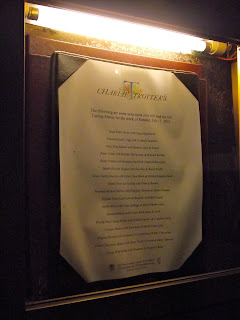 |
| The intersection of Lake & Marion in downtown Oak Park |
There may not be any scientific reason that the town was home to two of our country’s greatest artists, but their genius certainly wasn’t groomed in poverty. Oak Park was, and remains, one of the most beautiful communities you’ll come across. Modern mansions mix almost seamlessly with hundred-year old residences of striking beauty. The downtown continues to thrive with shops, restaurants, and a vintage movie palace.
 |
| Looking southward down Marion Street |
The boundaries: Unlike virtually every other Chicago suburb
(many of which look like an ink blot), the City of Oak Park is a perfect
box. The boundaries of the city
are North Avenue to the north, Roosevelt Road to the south, Austin Boulevard to
the east, and Harlem Avenue to the west.
The downtown is another interesting beast. Most downtowns are also called “central business districts” because they’re, well, centralized within the community. Oak Park’s downtown is AS FAR WEST AS YOU CAN GO within the town. It starts west at Harlem Avenue and runs a few blocks east to about Kenilworth Avenue. Lake Street runs right through the heart of the downtown. There’s a large commercial district west of Harlem Avenue that is more of a strip center and doesn’t really match the downtown feel of Oak Park. That’s because west of Oak Park is actually River Forest north of the train tracks, and becomes Forest Park south of the tracks. Oak Park, Forest Park, River Forest…got it? Good.
Population make-up: The population of Oak Park dropped slightly
as of the 2010
Census. The 2010
population was 51,878 down 1.2% from 2000. The racial make-up of Oak Park as of last year was 63.8%
white, 21.2% black, 6.8% Hispanic, and 4.8% Asian.
 |
| Frank Lloyd Wright Home and Studio |
Although the population has decreased noticeably from its 1940 high of 66,000 residents, Oak Park has held its position as one of Chicagoland’s most beloved destinations. In 2010, the Frank Lloyd Wright Historic District was named one of the APA’s (American Planning Association) “10 Great Neighborhoods”. Despite the westward growth of the Chicago metro area, Oak Park remains one of its true gems.
Getting there: By “L”, you’ve got multiple options. The Green Line will take you right to
downtown if you get off at Harlem/Lake or the Oak Park stop. There are also Green Line stops at
Ridgeland and Austin. The Blue Line makes
stops in the southern part of town at Harlem, Oak Park, and Austin.
CTA bus isn’t likely your best option, but you can get there going east-west via North (72) and Lake (20). Going north-south you can take Harlem (90), Ridgeland (86), and Austin (91). There are also multiple PACE routes that will get you around Oak Park: 305, 311, 315, 318, and 320.


